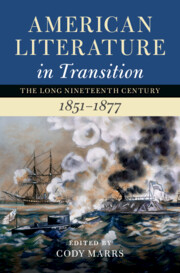Book contents
- American Literature in Transition, 1851–1877
- Nineteenth-Century American Literature in Transition
- American Literature in Transition, 1851–1877
- Copyright page
- Contents
- Figures
- Contributors
- Series Preface
- Introduction
- Part I Careers
- Part II Networks
- Chapter 8 Newspapers and Periodicals
- Chapter 9 Transamerican Literature
- Chapter 10 Oceanic Literature
- Chapter 11 Romanticism
- Chapter 12 Realism
- Part III Exchanges
- Part IV The Long Civil War
- Index
Chapter 10 - Oceanic Literature
from Part II - Networks
Published online by Cambridge University Press: 15 June 2022
- American Literature in Transition, 1851–1877
- Nineteenth-Century American Literature in Transition
- American Literature in Transition, 1851–1877
- Copyright page
- Contents
- Figures
- Contributors
- Series Preface
- Introduction
- Part I Careers
- Part II Networks
- Chapter 8 Newspapers and Periodicals
- Chapter 9 Transamerican Literature
- Chapter 10 Oceanic Literature
- Chapter 11 Romanticism
- Chapter 12 Realism
- Part III Exchanges
- Part IV The Long Civil War
- Index
Summary
The idea of the “oceanic” sits uneasily within the frame of nineteenth-century American literature. The categories “nineteenth-century,” “American,” and “literature” only partially account for the fluid and plural cultures of the ocean. A considerable part of the energy of the emerging field of oceanic studies comes from the ways in which it challenges traditional generic boundaries, historical eras, and conceptions of literature. A challenge in putting together a chapter about oceanic literature in nineteenth-century America – a task that is, fundamentally, about identifying a cogent and manageable archive – lies in dealing with the tensions that this energy generates. While it would be relatively simple to chronicle written texts about the sea by American authors, doing so would fail to tell the whole story about oceanic literature in the USA at this period of time. Conversely, if a limitation of this sort is not applied, the category of oceanic literature becomes so bloated as to become unmanageable and pointless. But a problem of this sort is ultimately a catalyzing one, for it foregrounds questions of definition that are significant when creating a primary body of texts of any sort. Accordingly, in what follows, the aim will be to build up gradually, from solid foundations – texts that are unproblematically American, oceanic, and, well, texts – into gradually more speculative terrains, where such designations might not hold. Along the way, the chapter will also allude to some of the theoretical issues that have structured the field for those who wish to explore them further as well as some of the sociopolitical and historical contexts that framed the life of the ocean in the era.
- Type
- Chapter
- Information
- American Literature in Transition, 1851–1877 , pp. 159 - 170Publisher: Cambridge University PressPrint publication year: 2022

